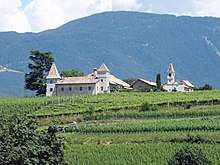Ansitz
An Ansitz is a small residence designed for the lower nobility of the Germanic Alpine region.

The "Ansitz Kreit" in Eppan, South Tyrol
History
The concept of Ansitz dates back to the end of the Middle Ages up to the 19th century. Unlike castles, they were hardly fortified. They arose when medieval fortifications had lost their military purpose. Residences were designed mainly for the comfortable and prestigious living of their owners. An Ansitz was often extremely ornate in design and furnished to denote the status of its owner.[1]
The application of the word Ansitz to refer to a noble residence is hardly used today outside South Tyrol, Bavaria, and Austria. As of 2008, there are 200 Ansitze remaining in Austria.[2]
gollark: When the class-μ bee entities incurse into reality.
gollark: ++help
gollark: $\mathbb{CONSUME}\ \mathbb{APIOFORMS}$
gollark: APIONET is all.
gollark: ++tel graph
References
- Hannes Obermair, Helmut Stampfer: Urbane Wohnkultur im spätmittelalterlichen Bozen. In: Schloß Runkelstein – die Bilderburg. Hrsg. von der Stadt Bozen unter Mitwirkung des Südtiroler Kulturinstitutes, Bozen: Athesia 2000. ISBN 88-8266-069-9, pp. 397–409, 398s.
- Andreas Weiss: Begriffe, Bezeichnungen und Namen von Burgen, Schlössern, Ansitzen. Salzburg, 12. December 2008, p. 5
This article is issued from Wikipedia. The text is licensed under Creative Commons - Attribution - Sharealike. Additional terms may apply for the media files.